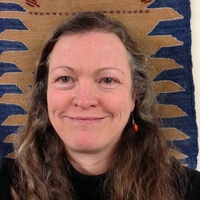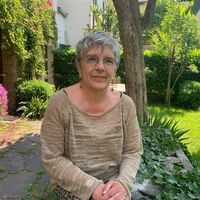Papers by Inge van der Jagt
In the second century AD in Borgharen near Maastricht (Netherlands) a Roman villa rustica was sit... more In the second century AD in Borgharen near Maastricht (Netherlands) a Roman villa rustica was situated on a gravel bed in the flood plan of the river Meuse. After the villa was abandoned and most of the building material was cleared away, in the 6th and 7th century the same spot was used as a cemetery. The very meticulous way of excavating combined with several specialisms (for example: physical anthropology, ancient DNA and stable isotopes research, archaeozoology) has given information not only about the villa, the graveyard and the burial ritual itself, but also about the formation processes, relationship and provenance of the buried people. Careful study of two horse skeletons made clear that these were ritually killed by a fatal stab in the heart; et cetera.

The distribution of the black rat (Rattus rattus) has been heavily influenced by its association ... more The distribution of the black rat (Rattus rattus) has been heavily influenced by its association with humans. The dispersal history of this non-native commensal rodent across Europe, however, remains poorly understood, and different introductions may have occurred during the Roman and medieval periods. Here, in order to reconstruct the population history of European black rats, we generated a de novo genome assembly of the black rat, 67 ancient black rat mitogenomes and 36 ancient nuclear genomes from sites spanning the 1st-17th centuries CE in Europe and North Africa. Analyses of mitochondrial DNA confirm that black rats were introduced into the Mediterranean and Europe from Southwest Asia. Genomic analyses of the ancient rats reveal a population turnover in temperate Europe between the 6th and 10th centuries CE, coincident with an archaeologically attested decline in the black rat population. The near disappearance and re-emergence of black rats in Europe may have been the result ...

Frontiers in Ecology and Evolution, 2021
Ancient DNA (aDNA) approaches have been successfully used to infer the long-term impacts of clima... more Ancient DNA (aDNA) approaches have been successfully used to infer the long-term impacts of climate change, domestication, and human exploitation in a range of terrestrial species. Nonetheless, studies investigating such impacts using aDNA in marine species are rare. Atlantic cod (Gadus morhua), is an economically important species that has experienced dramatic census population declines during the last century. Here, we investigated 48 ancient mitogenomes from historical specimens obtained from a range of archeological excavations in northern Europe dated up to 6,500 BCE. We compare these mitogenomes to those of 496 modern conspecifics sampled across the North Atlantic Ocean and adjacent seas. Our results confirm earlier observations of high levels of mitogenomic variation and a lack of mutation-drift equilibrium—suggestive of population expansion. Furthermore, our temporal comparison yields no evidence of measurable mitogenomic changes through time. Instead, our results indicate t...

Journal of Archaeological Science, 2021
The field of ancient DNA is dominated by studies focusing on terrestrial vertebrates. This taxono... more The field of ancient DNA is dominated by studies focusing on terrestrial vertebrates. This taxonomic bias limits our understanding of endogenous DNA preservation for species with different bone physiology, such as teleost fish. Teleost bone is typically brittle, porous, lightweight, and is characterized by a lack of bone remodeling during growth. All of these factors potentially affect DNA preservation. Using high-throughput shotgun sequencing, we here investigate the preservation of DNA in a range of different bone elements from over 200 archaeological Atlantic cod (Gadus morhua) specimens from 38 sites in northern Europe, dating up to 8000 years before present. We observe that the majority of archaeological sites (79%) yield endogenous DNA, with 40% of sites providing samples containing high levels (>20%). Library preparation success and levels of endogenous DNA depend mainly on excavation site and pre-extraction laboratory treatment. The use of pre-extraction treatments lowers the rate of libraries that can be sequenced, althoughif successfulthe fraction of endogenous DNA can be improved by several orders of magnitude. This trade-off between library preparation success and levels of endogenous DNA allows for alternative extraction strategies depending on the requirements of down-stream analyses and research questions. Finally, we do not find particular bone elements to yield higher levels of endogenous DNA, as is the case for denser bones in mammals. Our results highlight the potential of archaeological fish bone as a source for ancient DNA and suggest a possible role of bone remodeling in the preservation of endogenous DNA.
A Bouquet of Archaeozoological Studies
New Research into Early-Medieval Communities and Identities, 2015
Open Quaternary, 2019
More than fifty years ago, Anneke T. Clason published the first English-language archaeozoologica... more More than fifty years ago, Anneke T. Clason published the first English-language archaeozoological study on Dutch faunal assemblages. Inspired by the anniversary of this landmark publication, this paper presents a status overview of Dutch archaeozoology organized in twelve themes (e.g. rituals, Mesolithic-Neolithic transition, medieval period). The paper also discusses the common methods applied in Dutch archaeozoology, and includes extensive supplementary material that summarizes data from gray literature in Dutch. Our aim is to provide a guide to archaeozoological questions pertaining to the Netherlands and open a window for researchers working outside the Netherlands to the highly active world of Dutch archaeozoology.
Bakels, C., I. van der Jagt & R. Jansen, 2017: Livestock and plant resources in rural sites on sa... more Bakels, C., I. van der Jagt & R. Jansen, 2017: Livestock and plant resources in rural sites on sandy soil in the very north of northeastern Gaul, in: S. Lepetz & V.Zech-Matterne, Productions agro-pastorales, pratiques culturales et élevage dans le nord de la Gaule du deuxième siècle avant J.-C. à la fin de la période romaine (Archéologie des Plantes et des Animaux 5), 75-84.

in: A. Willemsen & H. Kik (eds.) Golden Middle Ages in Europe. New research into early-medieval communities and identities. Turnhout: Brepols Publishers, 2015
In the second century AD in Borgharen near Maastricht (Netherlands) a Roman villa rustica was sit... more In the second century AD in Borgharen near Maastricht (Netherlands) a Roman villa rustica was situated on a gravel bed in the flood plan of the river Meuse. After the villa was abandoned and most of the building material was cleared away, in the 6th and 7th century the same spot was used as a cemetery.
The very meticulous way of excavating combined with several specialisms (for example: physical anthropology, ancient DNA and stable isotopes research, archaeozoology) has given information not only about the villa, the graveyard and the burial ritual itself, but also about the formation processes, relationship and provenance of the buried peopl. Careful study of two horse skeletons made clear that these were ritually killed by a fatal stab in the heart; et cetera.
- 2015b: R. Lauwerier, J.-W. de Kort, E. Altena, L. Kootker, R. Panhuysen & I. van der Jagt : Merovingians at Borgharen : Digging into a listed monument near Maastricht (Netherlands), in: A. Willemsen & H. Kik (eds.), Golden Middle Ages in Europe: New Research into Early-Medieval Communities and Identities, Proceedings of the Second ‘Dorestad Congress’ held at the National Museum of Antiquities, Leiden, The Netherlands, 2-5 July, 2014, Turnhout: Brepols Publishers.
In: D.C.M. Raemaekers, E. Esser, R.C.G.M. Lauwerier & J.T. Zeiler (eds.) A bouquet of archaeological studies. Essays in honour of Wietske Prummel, GAS 21, 141-151, 2012

Quaternary International, Jan 1, 2011
Woerden, in the central part of The Netherlands, is a locality where the amateur-archaeologist Pi... more Woerden, in the central part of The Netherlands, is a locality where the amateur-archaeologist Pieter Stoel collected several thousands of fossil mammalian remains of Pleistocene age. The stratigraphically-mixed assemblage includes a broad variety of taxa including species that are indicative of interglacial conditions such as Hippopotamus sp. as well as species that inhabited the area during glacial episodes e.g. Mammuthus primigenius and Coelodonta antiquitatis. The fossil remains have an early Middle Pleistocene – Late Pleistocene age. Rangifer tarandus is one of the species that is very well represented in the faunal assemblage from Woerden.Woerden yielded not only thousands of fossil bones but also Palaeolithic artefacts. A direct relationship between the reindeer bones and these artefacts could not be indicated. Most of the bones are complete and not a single reindeer bone or bone fragment shows traces of human interference such as clear impact or cut marks. This is remarkable considering the many European Palaeolithic sites where reindeer hunters left their traces.Detailed investigation of the reindeer remains indicates that the majority of the reindeer remains from Woerden represent one population with juvenile as well as adult individuals. The adult specimens show a female/male ratio of 2:1, which is characteristic for natural living reindeer populations. This ratio as well as the standard deviation of the size measurements suggests that the assemblage is one distinct population and not a mix of fossil assemblages with reindeer of different size and different geological ages. Further remarkable is that the dimensions of the limb bones indicate that the reindeer from Woerden were extremely slender; much more slender than the fossil Middle and Late Pleistocene reindeer assemblages from other localities in north-western and central Europe.
Books by Inge van der Jagt
Nederlandse Archeologische rapporten, 2014
Subject of this monograph is the Late Neolothic site Zeewijk, that was located in a tidal environ... more Subject of this monograph is the Late Neolothic site Zeewijk, that was located in a tidal environment in the northwest of the Netherlands. The analyses show that Zeewijk was a location where recurrent habitation took place, year-round and intensive, alternating with subsistence activities. It is a permanent mosaic of different assemblages: relocated dwellings, cultivated plots, a large variety of local crafts and the building and partial demolition of a remarkable ritual structure in Zeewijk-East. This points to a community of several families, with ties of kinship both genetic and affinal.
Book Chapters by Inge van der Jagt

Since 2007, virtually all local authorities in the Netherlands have used archaeological resource ... more Since 2007, virtually all local authorities in the Netherlands have used archaeological resource maps, predictive archaeological maps and policy maps to help them meet their responsibility for heritage management. The Cultural Heritage Agency gathered and systematically analysed the maps in use: a total of 1666 maps and 611 accompanying reports. Subsequently national overviews of each type of map were produced. The predictive archaeological maps are based on predictive modelling combined with expert judgment. It is often unclear what predictions are actually based on. It was found that, when maps are fitted together, they do not match well in terms of either form or content. Differences between maps raise questions when it comes to projects that straddle municipal boundaries. The discrepancies are associated with the almost complete lack of overall detailed guidelines for map production, differences in the predictive models used, the sources consulted, the design and conditions imposed by the authorities commissioning the maps, as well as in the financial resources available. Central government is therefore keen to encourage local authorities to ensure that their predictive maps are more compatible in the future. Further, verifying the predictive models on the basis of resources identified in new field research could help enhance archaeological heritage management. This will enhance local authorities’ ability to make informed choices in their archaeology policy.
Study of the animal bones from the Merovingian cemetery of Borgharen (Maastricht). Special topics... more Study of the animal bones from the Merovingian cemetery of Borgharen (Maastricht). Special topics are: aDNA and spectroscopic analysis of an ivory ring from a woman's grave to determine the Elephant species, a detailed description and discussion on two horse burials, and an overview of the shells in the grave contents.

by Jørn Zeiler, Bjorn Smit, Roel Lauwerier, Sandra Beckerman, Inge van der Jagt, Lucy Kubiak-Martens, Virginia Garcia Diaz, Liesbeth Theunissen, Hans Peeters, Gary Nobles, and Jos Kleijne THEUNISSEN, E.M., BRINKKEMPER, O., LAUWERIER, R.C.G.M., SMIT, B.I., & I.M.M.VAN.DER.JAGT (eds.) A Mosaic of habitation at Zeewijk (the Netherlands). Late Neolithic Behavioural Variability in a Dynamic Landscape.
Zeewijk is an important final building block in the better understanding of Neolithic and Corded ... more Zeewijk is an important final building block in the better understanding of Neolithic and Corded Ware Culture life in Noord-Holland that we set out to achieve in our project. Looking back at the analysis and publication of the fairly small sites at Keinsmerbrug and Mienakker, the new information added by the much larger site Zeewijk is fascinating. Because Zeewijk is very different in many respects – in terms of the backlog, size, quantity of finds and proportion excavated – its story is a valuable outcome of our Odyssey research project.
We can conclude that Zeewijk was a large domestic settlement, occupied all year round. In our view Zeewijk must be seen as a location where recurrent habitation took place, intensively, alternated with subsistence activities. It is a permanent mosaic of different assemblages: relocated dwellings, cultivated plots and the building and partial demolition of a remarkable ritual structure.
The habitants of Zeewijk carried out a broad spectrum of activities related to subsistence: mixed intensive farming (including small-scale crop cultivation, crop processing and
consumption, and animal herding and consumption), foraging, fishing, fowling and hunting all took place there. Furthermore there is ample evidence of craftsmanship.
This variety of local crafts, the construction and use of the large ceremonial building in Zeewijk-East and the large variation in ceramics are seen as indications that different groups of
Corded Ware people settled at Zeewijk. These groups were probably household groups, a community of several families, related by kinship both genetic and affinal.
[In Dutch] Discussion and conclusion concerning the Merovingian cemeteray at Borgharen near Maast... more [In Dutch] Discussion and conclusion concerning the Merovingian cemeteray at Borgharen near Maastricht (Netherlands).











Uploads
Papers by Inge van der Jagt
The very meticulous way of excavating combined with several specialisms (for example: physical anthropology, ancient DNA and stable isotopes research, archaeozoology) has given information not only about the villa, the graveyard and the burial ritual itself, but also about the formation processes, relationship and provenance of the buried peopl. Careful study of two horse skeletons made clear that these were ritually killed by a fatal stab in the heart; et cetera.
- 2015b: R. Lauwerier, J.-W. de Kort, E. Altena, L. Kootker, R. Panhuysen & I. van der Jagt : Merovingians at Borgharen : Digging into a listed monument near Maastricht (Netherlands), in: A. Willemsen & H. Kik (eds.), Golden Middle Ages in Europe: New Research into Early-Medieval Communities and Identities, Proceedings of the Second ‘Dorestad Congress’ held at the National Museum of Antiquities, Leiden, The Netherlands, 2-5 July, 2014, Turnhout: Brepols Publishers.
Books by Inge van der Jagt
Book Chapters by Inge van der Jagt
We can conclude that Zeewijk was a large domestic settlement, occupied all year round. In our view Zeewijk must be seen as a location where recurrent habitation took place, intensively, alternated with subsistence activities. It is a permanent mosaic of different assemblages: relocated dwellings, cultivated plots and the building and partial demolition of a remarkable ritual structure.
The habitants of Zeewijk carried out a broad spectrum of activities related to subsistence: mixed intensive farming (including small-scale crop cultivation, crop processing and
consumption, and animal herding and consumption), foraging, fishing, fowling and hunting all took place there. Furthermore there is ample evidence of craftsmanship.
This variety of local crafts, the construction and use of the large ceremonial building in Zeewijk-East and the large variation in ceramics are seen as indications that different groups of
Corded Ware people settled at Zeewijk. These groups were probably household groups, a community of several families, related by kinship both genetic and affinal.
The very meticulous way of excavating combined with several specialisms (for example: physical anthropology, ancient DNA and stable isotopes research, archaeozoology) has given information not only about the villa, the graveyard and the burial ritual itself, but also about the formation processes, relationship and provenance of the buried peopl. Careful study of two horse skeletons made clear that these were ritually killed by a fatal stab in the heart; et cetera.
- 2015b: R. Lauwerier, J.-W. de Kort, E. Altena, L. Kootker, R. Panhuysen & I. van der Jagt : Merovingians at Borgharen : Digging into a listed monument near Maastricht (Netherlands), in: A. Willemsen & H. Kik (eds.), Golden Middle Ages in Europe: New Research into Early-Medieval Communities and Identities, Proceedings of the Second ‘Dorestad Congress’ held at the National Museum of Antiquities, Leiden, The Netherlands, 2-5 July, 2014, Turnhout: Brepols Publishers.
We can conclude that Zeewijk was a large domestic settlement, occupied all year round. In our view Zeewijk must be seen as a location where recurrent habitation took place, intensively, alternated with subsistence activities. It is a permanent mosaic of different assemblages: relocated dwellings, cultivated plots and the building and partial demolition of a remarkable ritual structure.
The habitants of Zeewijk carried out a broad spectrum of activities related to subsistence: mixed intensive farming (including small-scale crop cultivation, crop processing and
consumption, and animal herding and consumption), foraging, fishing, fowling and hunting all took place there. Furthermore there is ample evidence of craftsmanship.
This variety of local crafts, the construction and use of the large ceremonial building in Zeewijk-East and the large variation in ceramics are seen as indications that different groups of
Corded Ware people settled at Zeewijk. These groups were probably household groups, a community of several families, related by kinship both genetic and affinal.